Queens Hospital: Supply Chain Management and Service Delivery Report
VerifiedAdded on 2021/02/19
|11
|3362
|41
Report
AI Summary
This report provides a comprehensive analysis of the supply chain management, operational functions, and service delivery systems at Queens Hospital, located in Romford, London. It begins with an introduction to supply chain management and its significance in healthcare, highlighting the importance of timely raw material supply for patient care. The main body of the report delves into various supply chain issues faced by the hospital, such as overnight shipping challenges, hidden costs, drug shortages, data limitations, lack of integration, weak charge capture, physician preferences, and poor workflow design. It then explores the operational functions that support the hospital, including supply chain management, marketing, human resources, and finance, emphasizing the need for efficient operations to control costs and maintain quality service. The report also examines the service delivery system, including the roles of service staff, IT teams, data collection processes, and inventory management. Furthermore, it outlines the infrastructure used to manage the delivery system, focusing on facility management. The report concludes with recommendations for improving business performance, aiming to enhance the overall efficiency and effectiveness of Queens Hospital's operations.
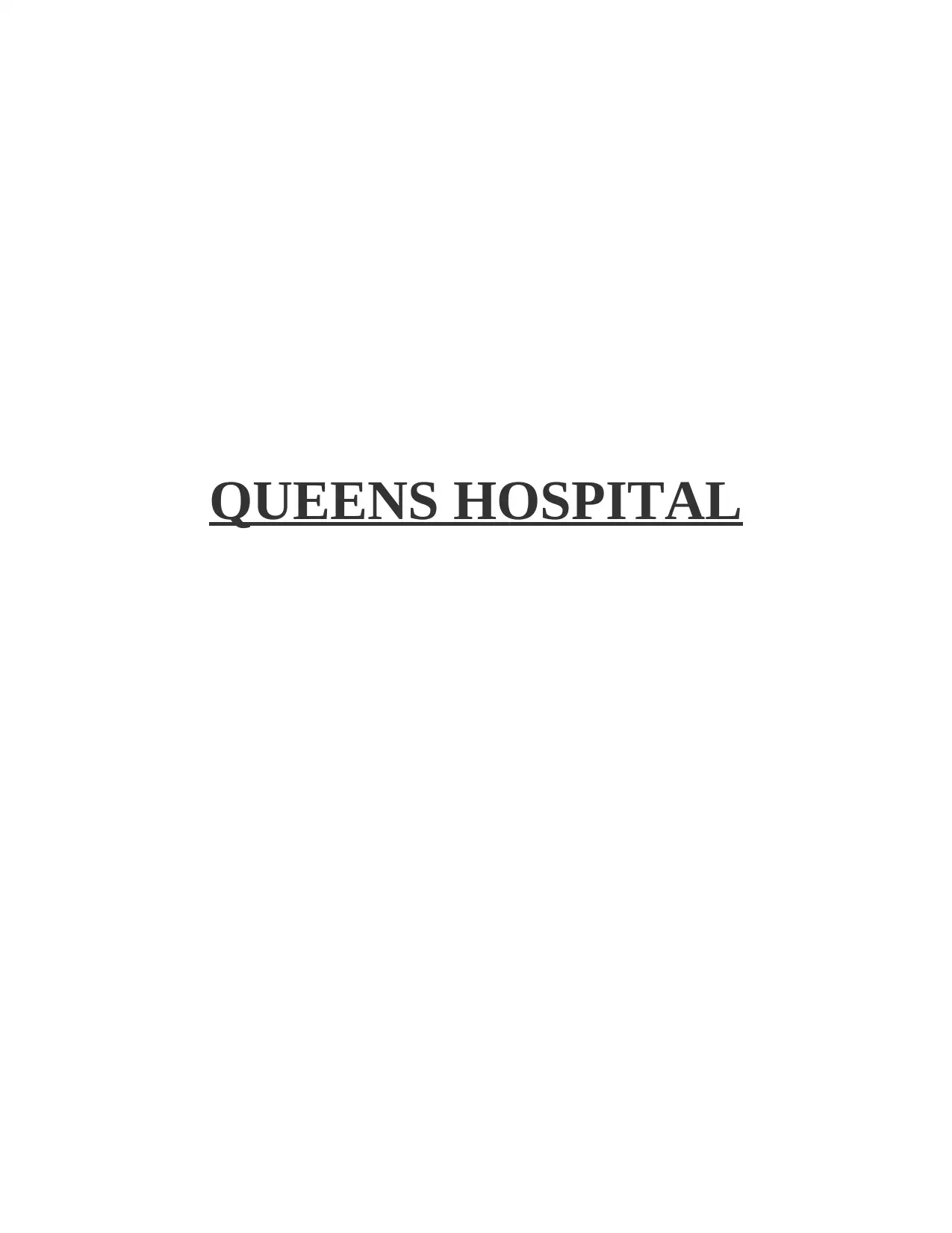
QUEENS HOSPITAL
Paraphrase This Document
Need a fresh take? Get an instant paraphrase of this document with our AI Paraphraser
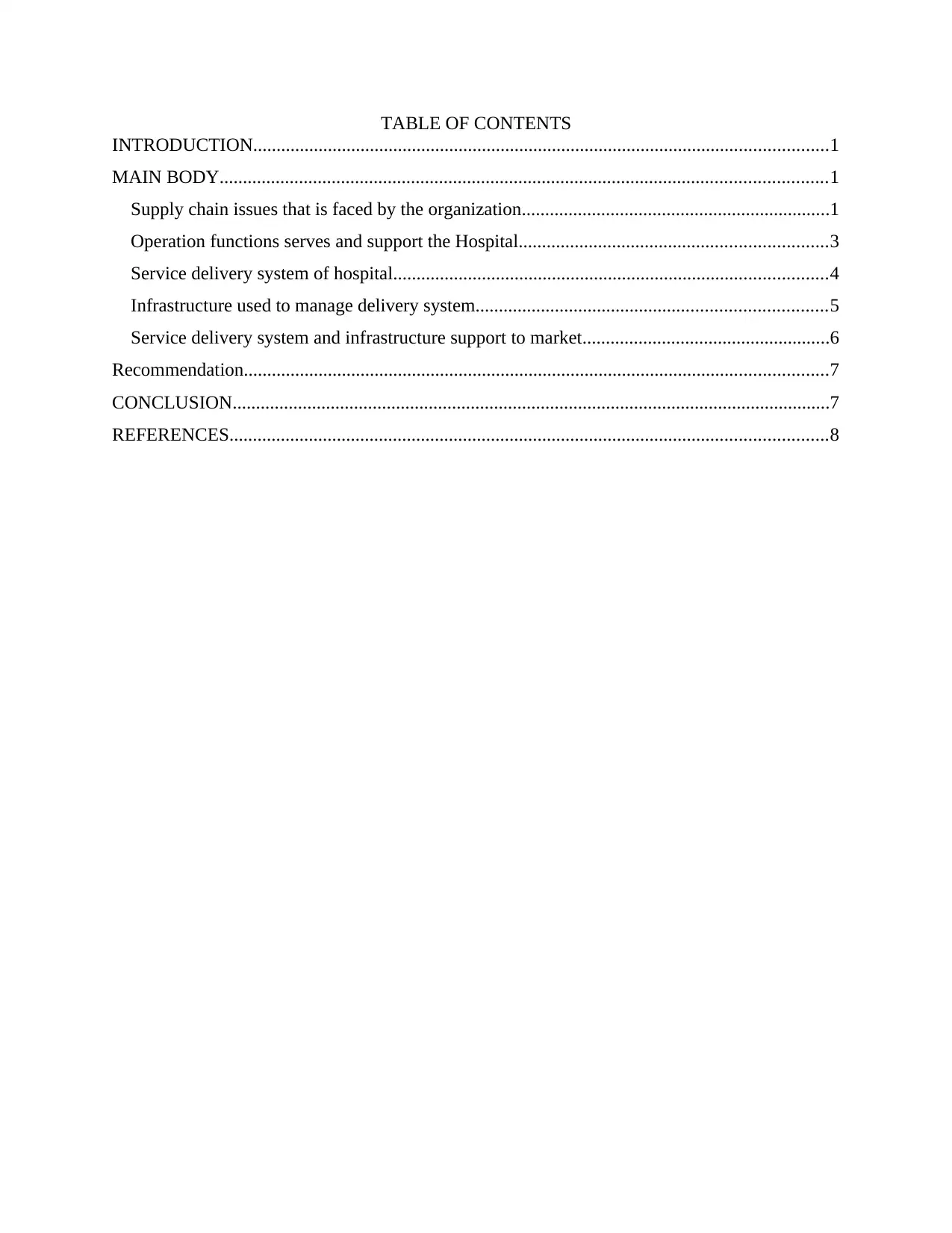
TABLE OF CONTENTS
INTRODUCTION...........................................................................................................................1
MAIN BODY..................................................................................................................................1
Supply chain issues that is faced by the organization..................................................................1
Operation functions serves and support the Hospital..................................................................3
Service delivery system of hospital.............................................................................................4
Infrastructure used to manage delivery system...........................................................................5
Service delivery system and infrastructure support to market.....................................................6
Recommendation.............................................................................................................................7
CONCLUSION................................................................................................................................7
REFERENCES................................................................................................................................8
INTRODUCTION...........................................................................................................................1
MAIN BODY..................................................................................................................................1
Supply chain issues that is faced by the organization..................................................................1
Operation functions serves and support the Hospital..................................................................3
Service delivery system of hospital.............................................................................................4
Infrastructure used to manage delivery system...........................................................................5
Service delivery system and infrastructure support to market.....................................................6
Recommendation.............................................................................................................................7
CONCLUSION................................................................................................................................7
REFERENCES................................................................................................................................8
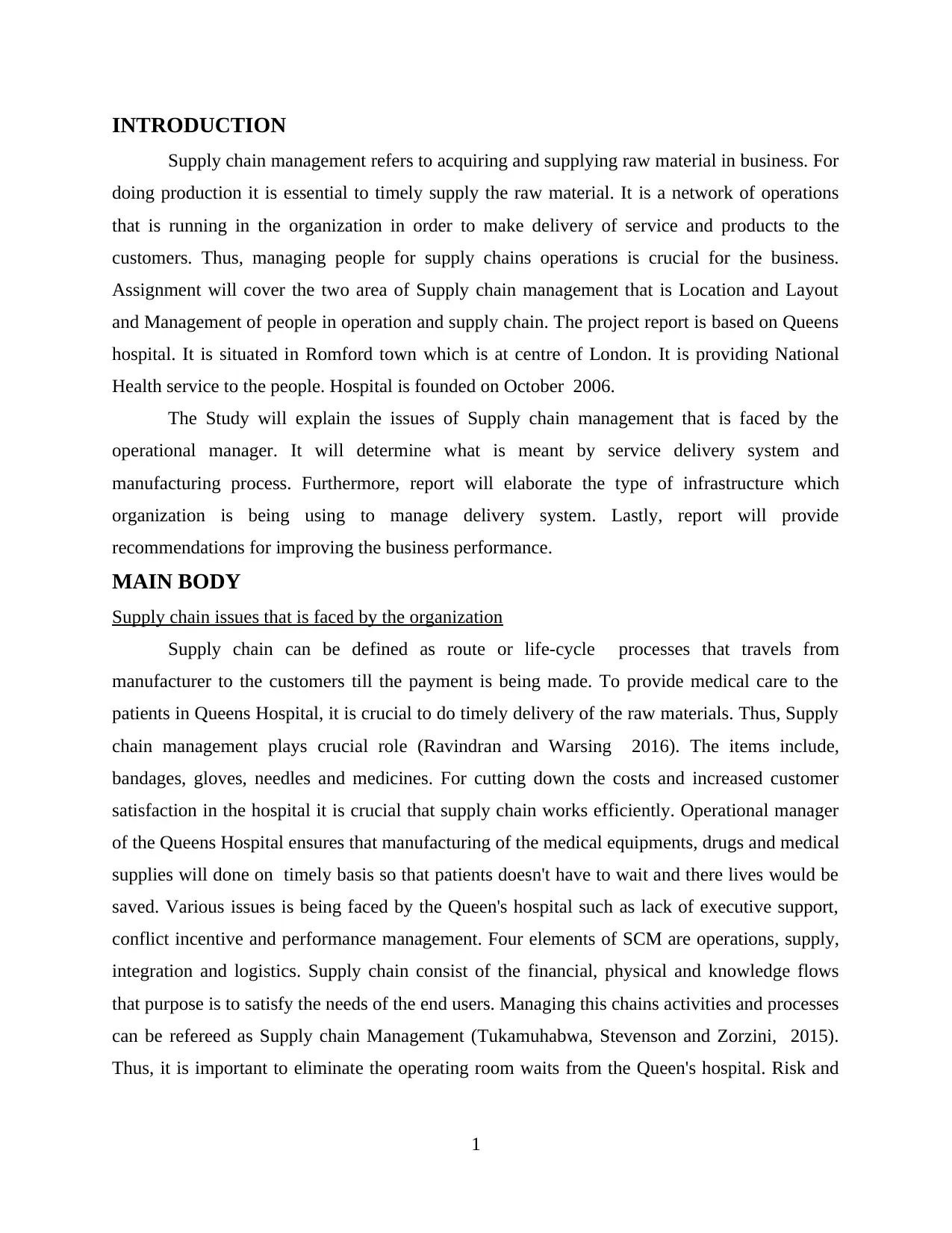
INTRODUCTION
Supply chain management refers to acquiring and supplying raw material in business. For
doing production it is essential to timely supply the raw material. It is a network of operations
that is running in the organization in order to make delivery of service and products to the
customers. Thus, managing people for supply chains operations is crucial for the business.
Assignment will cover the two area of Supply chain management that is Location and Layout
and Management of people in operation and supply chain. The project report is based on Queens
hospital. It is situated in Romford town which is at centre of London. It is providing National
Health service to the people. Hospital is founded on October 2006.
The Study will explain the issues of Supply chain management that is faced by the
operational manager. It will determine what is meant by service delivery system and
manufacturing process. Furthermore, report will elaborate the type of infrastructure which
organization is being using to manage delivery system. Lastly, report will provide
recommendations for improving the business performance.
MAIN BODY
Supply chain issues that is faced by the organization
Supply chain can be defined as route or life-cycle processes that travels from
manufacturer to the customers till the payment is being made. To provide medical care to the
patients in Queens Hospital, it is crucial to do timely delivery of the raw materials. Thus, Supply
chain management plays crucial role (Ravindran and Warsing 2016). The items include,
bandages, gloves, needles and medicines. For cutting down the costs and increased customer
satisfaction in the hospital it is crucial that supply chain works efficiently. Operational manager
of the Queens Hospital ensures that manufacturing of the medical equipments, drugs and medical
supplies will done on timely basis so that patients doesn't have to wait and there lives would be
saved. Various issues is being faced by the Queen's hospital such as lack of executive support,
conflict incentive and performance management. Four elements of SCM are operations, supply,
integration and logistics. Supply chain consist of the financial, physical and knowledge flows
that purpose is to satisfy the needs of the end users. Managing this chains activities and processes
can be refereed as Supply chain Management (Tukamuhabwa, Stevenson and Zorzini, 2015).
Thus, it is important to eliminate the operating room waits from the Queen's hospital. Risk and
1
Supply chain management refers to acquiring and supplying raw material in business. For
doing production it is essential to timely supply the raw material. It is a network of operations
that is running in the organization in order to make delivery of service and products to the
customers. Thus, managing people for supply chains operations is crucial for the business.
Assignment will cover the two area of Supply chain management that is Location and Layout
and Management of people in operation and supply chain. The project report is based on Queens
hospital. It is situated in Romford town which is at centre of London. It is providing National
Health service to the people. Hospital is founded on October 2006.
The Study will explain the issues of Supply chain management that is faced by the
operational manager. It will determine what is meant by service delivery system and
manufacturing process. Furthermore, report will elaborate the type of infrastructure which
organization is being using to manage delivery system. Lastly, report will provide
recommendations for improving the business performance.
MAIN BODY
Supply chain issues that is faced by the organization
Supply chain can be defined as route or life-cycle processes that travels from
manufacturer to the customers till the payment is being made. To provide medical care to the
patients in Queens Hospital, it is crucial to do timely delivery of the raw materials. Thus, Supply
chain management plays crucial role (Ravindran and Warsing 2016). The items include,
bandages, gloves, needles and medicines. For cutting down the costs and increased customer
satisfaction in the hospital it is crucial that supply chain works efficiently. Operational manager
of the Queens Hospital ensures that manufacturing of the medical equipments, drugs and medical
supplies will done on timely basis so that patients doesn't have to wait and there lives would be
saved. Various issues is being faced by the Queen's hospital such as lack of executive support,
conflict incentive and performance management. Four elements of SCM are operations, supply,
integration and logistics. Supply chain consist of the financial, physical and knowledge flows
that purpose is to satisfy the needs of the end users. Managing this chains activities and processes
can be refereed as Supply chain Management (Tukamuhabwa, Stevenson and Zorzini, 2015).
Thus, it is important to eliminate the operating room waits from the Queen's hospital. Risk and
1
⊘ This is a preview!⊘
Do you want full access?
Subscribe today to unlock all pages.

Trusted by 1+ million students worldwide
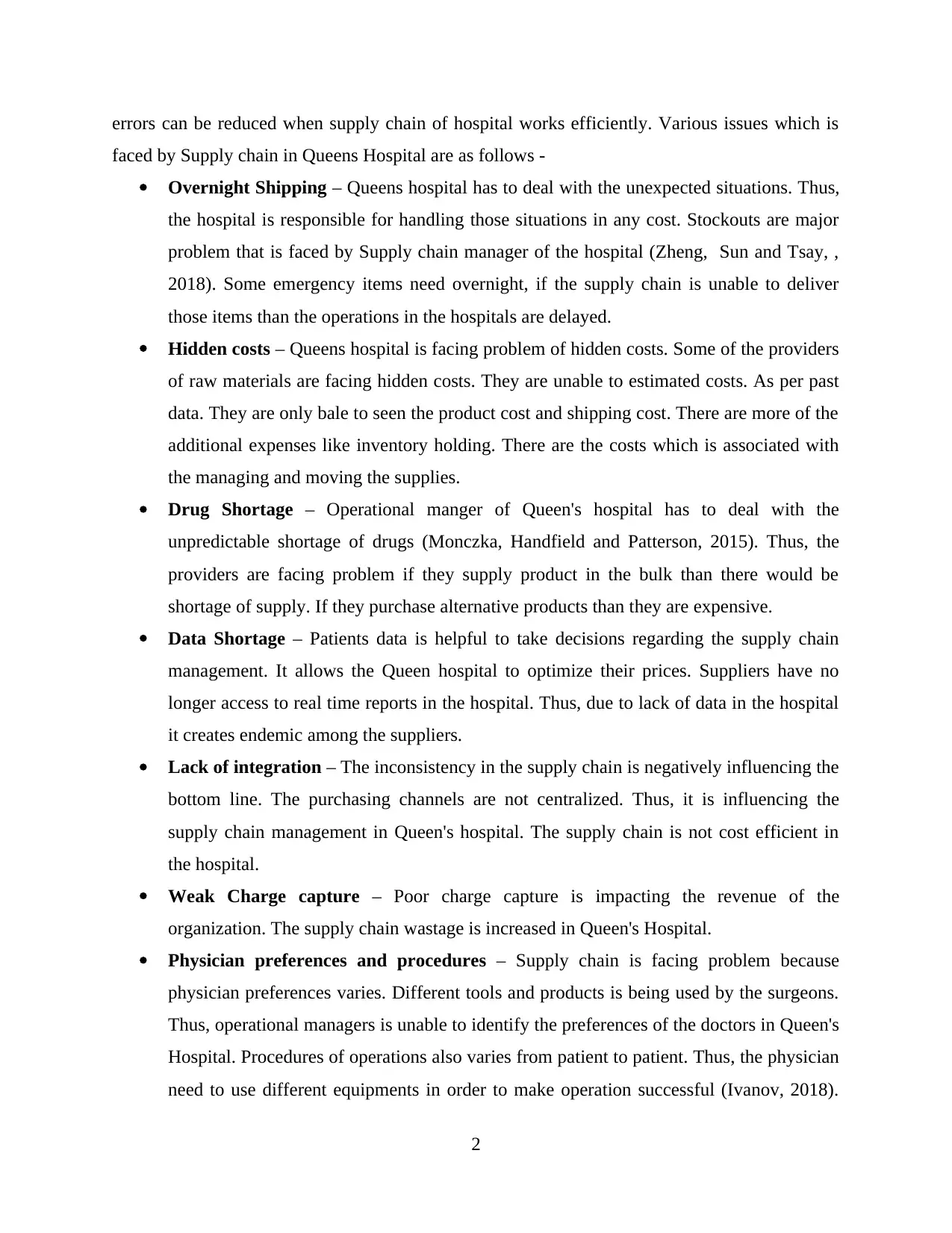
errors can be reduced when supply chain of hospital works efficiently. Various issues which is
faced by Supply chain in Queens Hospital are as follows -
Overnight Shipping – Queens hospital has to deal with the unexpected situations. Thus,
the hospital is responsible for handling those situations in any cost. Stockouts are major
problem that is faced by Supply chain manager of the hospital (Zheng, Sun and Tsay, ,
2018). Some emergency items need overnight, if the supply chain is unable to deliver
those items than the operations in the hospitals are delayed.
Hidden costs – Queens hospital is facing problem of hidden costs. Some of the providers
of raw materials are facing hidden costs. They are unable to estimated costs. As per past
data. They are only bale to seen the product cost and shipping cost. There are more of the
additional expenses like inventory holding. There are the costs which is associated with
the managing and moving the supplies.
Drug Shortage – Operational manger of Queen's hospital has to deal with the
unpredictable shortage of drugs (Monczka, Handfield and Patterson, 2015). Thus, the
providers are facing problem if they supply product in the bulk than there would be
shortage of supply. If they purchase alternative products than they are expensive.
Data Shortage – Patients data is helpful to take decisions regarding the supply chain
management. It allows the Queen hospital to optimize their prices. Suppliers have no
longer access to real time reports in the hospital. Thus, due to lack of data in the hospital
it creates endemic among the suppliers.
Lack of integration – The inconsistency in the supply chain is negatively influencing the
bottom line. The purchasing channels are not centralized. Thus, it is influencing the
supply chain management in Queen's hospital. The supply chain is not cost efficient in
the hospital.
Weak Charge capture – Poor charge capture is impacting the revenue of the
organization. The supply chain wastage is increased in Queen's Hospital.
Physician preferences and procedures – Supply chain is facing problem because
physician preferences varies. Different tools and products is being used by the surgeons.
Thus, operational managers is unable to identify the preferences of the doctors in Queen's
Hospital. Procedures of operations also varies from patient to patient. Thus, the physician
need to use different equipments in order to make operation successful (Ivanov, 2018).
2
faced by Supply chain in Queens Hospital are as follows -
Overnight Shipping – Queens hospital has to deal with the unexpected situations. Thus,
the hospital is responsible for handling those situations in any cost. Stockouts are major
problem that is faced by Supply chain manager of the hospital (Zheng, Sun and Tsay, ,
2018). Some emergency items need overnight, if the supply chain is unable to deliver
those items than the operations in the hospitals are delayed.
Hidden costs – Queens hospital is facing problem of hidden costs. Some of the providers
of raw materials are facing hidden costs. They are unable to estimated costs. As per past
data. They are only bale to seen the product cost and shipping cost. There are more of the
additional expenses like inventory holding. There are the costs which is associated with
the managing and moving the supplies.
Drug Shortage – Operational manger of Queen's hospital has to deal with the
unpredictable shortage of drugs (Monczka, Handfield and Patterson, 2015). Thus, the
providers are facing problem if they supply product in the bulk than there would be
shortage of supply. If they purchase alternative products than they are expensive.
Data Shortage – Patients data is helpful to take decisions regarding the supply chain
management. It allows the Queen hospital to optimize their prices. Suppliers have no
longer access to real time reports in the hospital. Thus, due to lack of data in the hospital
it creates endemic among the suppliers.
Lack of integration – The inconsistency in the supply chain is negatively influencing the
bottom line. The purchasing channels are not centralized. Thus, it is influencing the
supply chain management in Queen's hospital. The supply chain is not cost efficient in
the hospital.
Weak Charge capture – Poor charge capture is impacting the revenue of the
organization. The supply chain wastage is increased in Queen's Hospital.
Physician preferences and procedures – Supply chain is facing problem because
physician preferences varies. Different tools and products is being used by the surgeons.
Thus, operational managers is unable to identify the preferences of the doctors in Queen's
Hospital. Procedures of operations also varies from patient to patient. Thus, the physician
need to use different equipments in order to make operation successful (Ivanov, 2018).
2
Paraphrase This Document
Need a fresh take? Get an instant paraphrase of this document with our AI Paraphraser
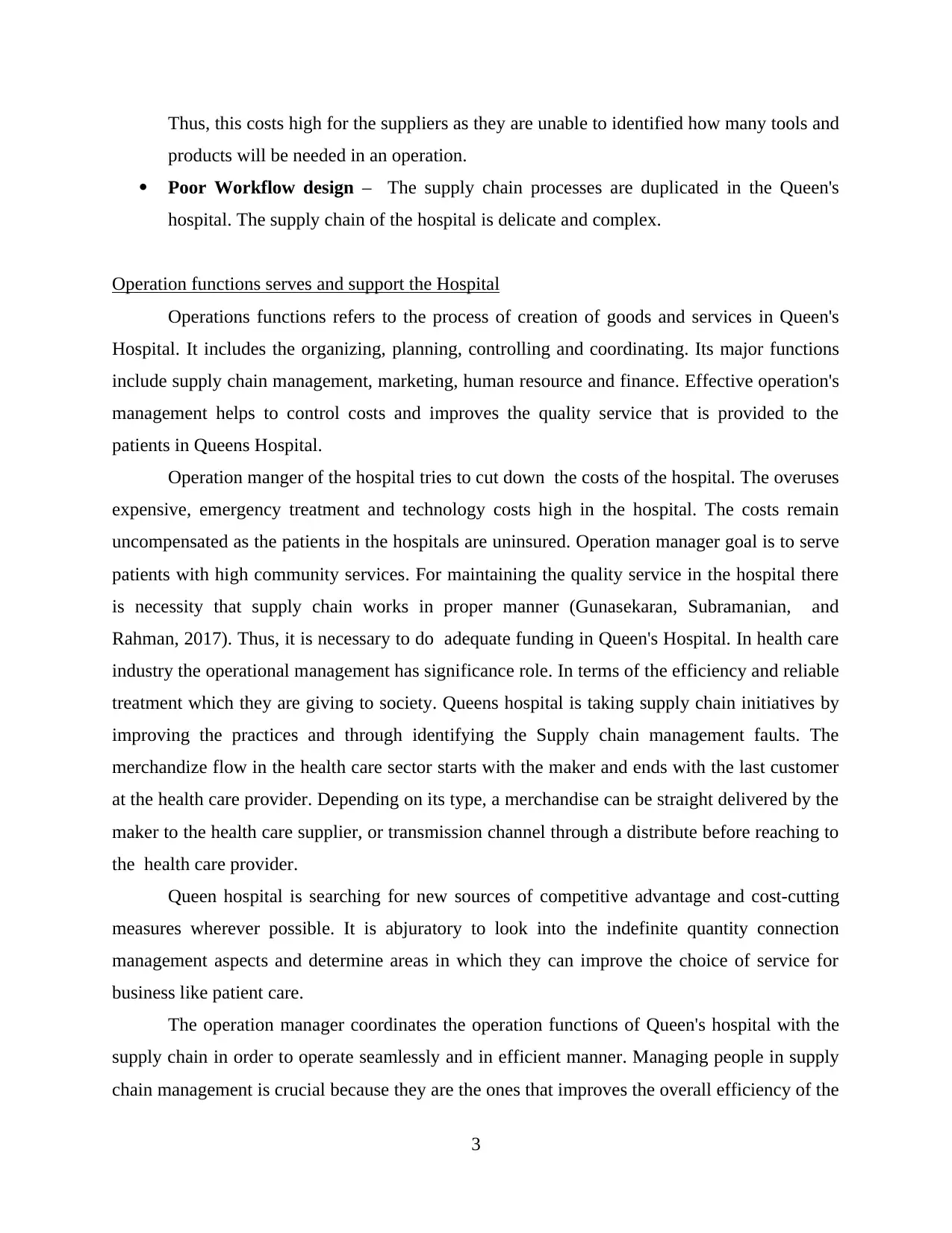
Thus, this costs high for the suppliers as they are unable to identified how many tools and
products will be needed in an operation.
Poor Workflow design – The supply chain processes are duplicated in the Queen's
hospital. The supply chain of the hospital is delicate and complex.
Operation functions serves and support the Hospital
Operations functions refers to the process of creation of goods and services in Queen's
Hospital. It includes the organizing, planning, controlling and coordinating. Its major functions
include supply chain management, marketing, human resource and finance. Effective operation's
management helps to control costs and improves the quality service that is provided to the
patients in Queens Hospital.
Operation manger of the hospital tries to cut down the costs of the hospital. The overuses
expensive, emergency treatment and technology costs high in the hospital. The costs remain
uncompensated as the patients in the hospitals are uninsured. Operation manager goal is to serve
patients with high community services. For maintaining the quality service in the hospital there
is necessity that supply chain works in proper manner (Gunasekaran, Subramanian, and
Rahman, 2017). Thus, it is necessary to do adequate funding in Queen's Hospital. In health care
industry the operational management has significance role. In terms of the efficiency and reliable
treatment which they are giving to society. Queens hospital is taking supply chain initiatives by
improving the practices and through identifying the Supply chain management faults. The
merchandize flow in the health care sector starts with the maker and ends with the last customer
at the health care provider. Depending on its type, a merchandise can be straight delivered by the
maker to the health care supplier, or transmission channel through a distribute before reaching to
the health care provider.
Queen hospital is searching for new sources of competitive advantage and cost-cutting
measures wherever possible. It is abjuratory to look into the indefinite quantity connection
management aspects and determine areas in which they can improve the choice of service for
business like patient care.
The operation manager coordinates the operation functions of Queen's hospital with the
supply chain in order to operate seamlessly and in efficient manner. Managing people in supply
chain management is crucial because they are the ones that improves the overall efficiency of the
3
products will be needed in an operation.
Poor Workflow design – The supply chain processes are duplicated in the Queen's
hospital. The supply chain of the hospital is delicate and complex.
Operation functions serves and support the Hospital
Operations functions refers to the process of creation of goods and services in Queen's
Hospital. It includes the organizing, planning, controlling and coordinating. Its major functions
include supply chain management, marketing, human resource and finance. Effective operation's
management helps to control costs and improves the quality service that is provided to the
patients in Queens Hospital.
Operation manger of the hospital tries to cut down the costs of the hospital. The overuses
expensive, emergency treatment and technology costs high in the hospital. The costs remain
uncompensated as the patients in the hospitals are uninsured. Operation manager goal is to serve
patients with high community services. For maintaining the quality service in the hospital there
is necessity that supply chain works in proper manner (Gunasekaran, Subramanian, and
Rahman, 2017). Thus, it is necessary to do adequate funding in Queen's Hospital. In health care
industry the operational management has significance role. In terms of the efficiency and reliable
treatment which they are giving to society. Queens hospital is taking supply chain initiatives by
improving the practices and through identifying the Supply chain management faults. The
merchandize flow in the health care sector starts with the maker and ends with the last customer
at the health care provider. Depending on its type, a merchandise can be straight delivered by the
maker to the health care supplier, or transmission channel through a distribute before reaching to
the health care provider.
Queen hospital is searching for new sources of competitive advantage and cost-cutting
measures wherever possible. It is abjuratory to look into the indefinite quantity connection
management aspects and determine areas in which they can improve the choice of service for
business like patient care.
The operation manager coordinates the operation functions of Queen's hospital with the
supply chain in order to operate seamlessly and in efficient manner. Managing people in supply
chain management is crucial because they are the ones that improves the overall efficiency of the
3
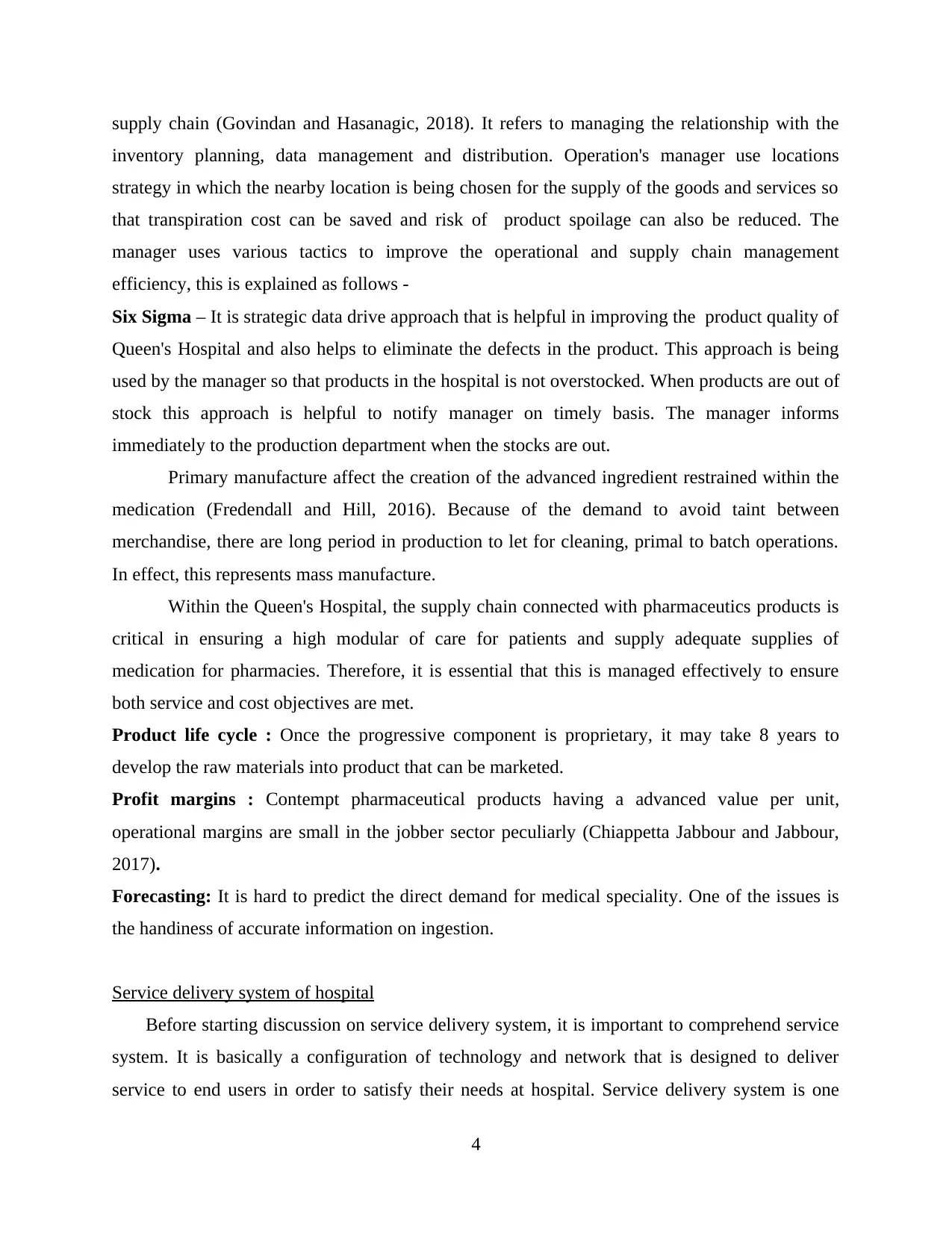
supply chain (Govindan and Hasanagic, 2018). It refers to managing the relationship with the
inventory planning, data management and distribution. Operation's manager use locations
strategy in which the nearby location is being chosen for the supply of the goods and services so
that transpiration cost can be saved and risk of product spoilage can also be reduced. The
manager uses various tactics to improve the operational and supply chain management
efficiency, this is explained as follows -
Six Sigma – It is strategic data drive approach that is helpful in improving the product quality of
Queen's Hospital and also helps to eliminate the defects in the product. This approach is being
used by the manager so that products in the hospital is not overstocked. When products are out of
stock this approach is helpful to notify manager on timely basis. The manager informs
immediately to the production department when the stocks are out.
Primary manufacture affect the creation of the advanced ingredient restrained within the
medication (Fredendall and Hill, 2016). Because of the demand to avoid taint between
merchandise, there are long period in production to let for cleaning, primal to batch operations.
In effect, this represents mass manufacture.
Within the Queen's Hospital, the supply chain connected with pharmaceutics products is
critical in ensuring a high modular of care for patients and supply adequate supplies of
medication for pharmacies. Therefore, it is essential that this is managed effectively to ensure
both service and cost objectives are met.
Product life cycle : Once the progressive component is proprietary, it may take 8 years to
develop the raw materials into product that can be marketed.
Profit margins : Contempt pharmaceutical products having a advanced value per unit,
operational margins are small in the jobber sector peculiarly (Chiappetta Jabbour and Jabbour,
2017).
Forecasting: It is hard to predict the direct demand for medical speciality. One of the issues is
the handiness of accurate information on ingestion.
Service delivery system of hospital
Before starting discussion on service delivery system, it is important to comprehend service
system. It is basically a configuration of technology and network that is designed to deliver
service to end users in order to satisfy their needs at hospital. Service delivery system is one
4
inventory planning, data management and distribution. Operation's manager use locations
strategy in which the nearby location is being chosen for the supply of the goods and services so
that transpiration cost can be saved and risk of product spoilage can also be reduced. The
manager uses various tactics to improve the operational and supply chain management
efficiency, this is explained as follows -
Six Sigma – It is strategic data drive approach that is helpful in improving the product quality of
Queen's Hospital and also helps to eliminate the defects in the product. This approach is being
used by the manager so that products in the hospital is not overstocked. When products are out of
stock this approach is helpful to notify manager on timely basis. The manager informs
immediately to the production department when the stocks are out.
Primary manufacture affect the creation of the advanced ingredient restrained within the
medication (Fredendall and Hill, 2016). Because of the demand to avoid taint between
merchandise, there are long period in production to let for cleaning, primal to batch operations.
In effect, this represents mass manufacture.
Within the Queen's Hospital, the supply chain connected with pharmaceutics products is
critical in ensuring a high modular of care for patients and supply adequate supplies of
medication for pharmacies. Therefore, it is essential that this is managed effectively to ensure
both service and cost objectives are met.
Product life cycle : Once the progressive component is proprietary, it may take 8 years to
develop the raw materials into product that can be marketed.
Profit margins : Contempt pharmaceutical products having a advanced value per unit,
operational margins are small in the jobber sector peculiarly (Chiappetta Jabbour and Jabbour,
2017).
Forecasting: It is hard to predict the direct demand for medical speciality. One of the issues is
the handiness of accurate information on ingestion.
Service delivery system of hospital
Before starting discussion on service delivery system, it is important to comprehend service
system. It is basically a configuration of technology and network that is designed to deliver
service to end users in order to satisfy their needs at hospital. Service delivery system is one
4
⊘ This is a preview!⊘
Do you want full access?
Subscribe today to unlock all pages.

Trusted by 1+ million students worldwide
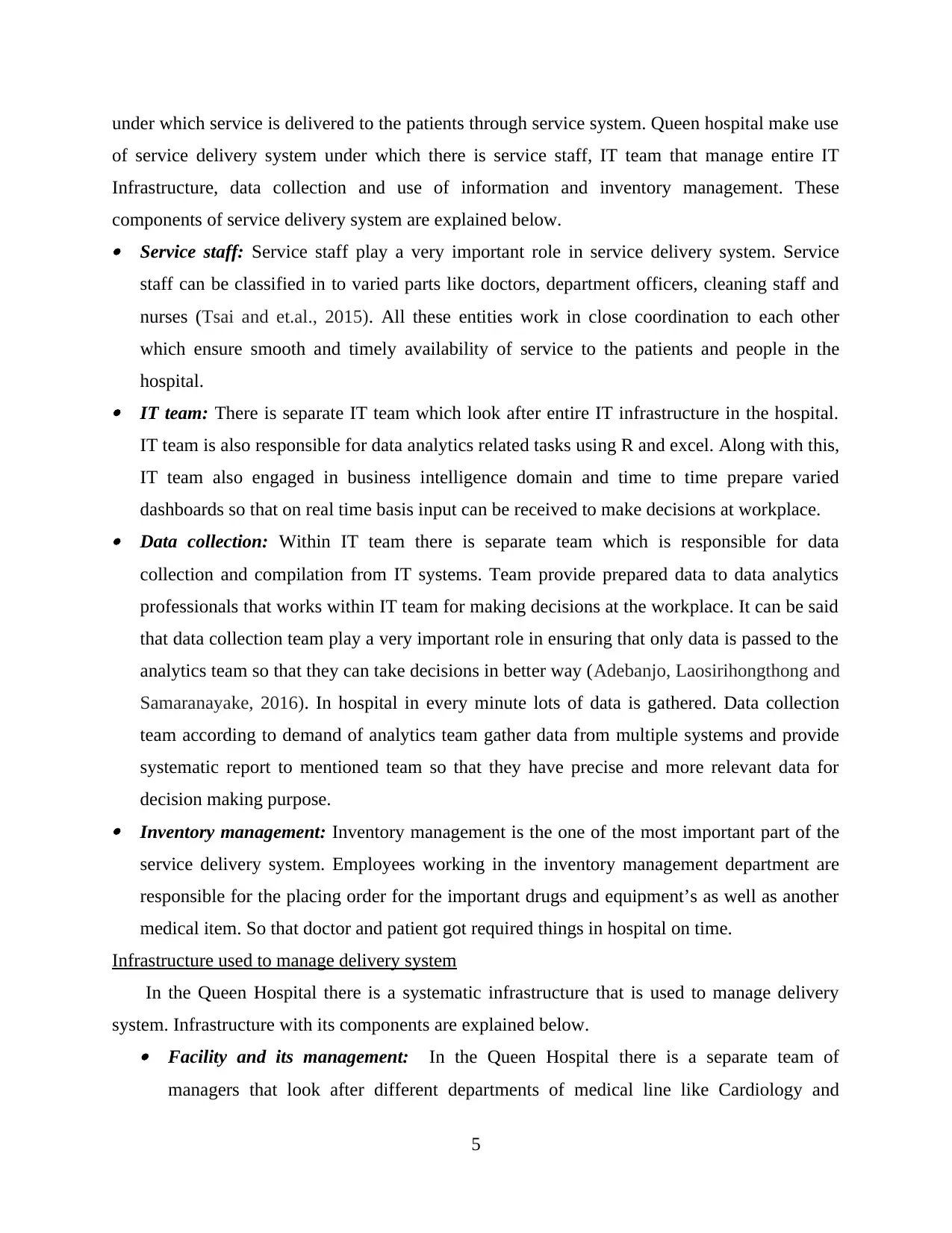
under which service is delivered to the patients through service system. Queen hospital make use
of service delivery system under which there is service staff, IT team that manage entire IT
Infrastructure, data collection and use of information and inventory management. These
components of service delivery system are explained below. Service staff: Service staff play a very important role in service delivery system. Service
staff can be classified in to varied parts like doctors, department officers, cleaning staff and
nurses (Tsai and et.al., 2015). All these entities work in close coordination to each other
which ensure smooth and timely availability of service to the patients and people in the
hospital. IT team: There is separate IT team which look after entire IT infrastructure in the hospital.
IT team is also responsible for data analytics related tasks using R and excel. Along with this,
IT team also engaged in business intelligence domain and time to time prepare varied
dashboards so that on real time basis input can be received to make decisions at workplace. Data collection: Within IT team there is separate team which is responsible for data
collection and compilation from IT systems. Team provide prepared data to data analytics
professionals that works within IT team for making decisions at the workplace. It can be said
that data collection team play a very important role in ensuring that only data is passed to the
analytics team so that they can take decisions in better way (Adebanjo, Laosirihongthong and
Samaranayake, 2016). In hospital in every minute lots of data is gathered. Data collection
team according to demand of analytics team gather data from multiple systems and provide
systematic report to mentioned team so that they have precise and more relevant data for
decision making purpose. Inventory management: Inventory management is the one of the most important part of the
service delivery system. Employees working in the inventory management department are
responsible for the placing order for the important drugs and equipment’s as well as another
medical item. So that doctor and patient got required things in hospital on time.
Infrastructure used to manage delivery system
In the Queen Hospital there is a systematic infrastructure that is used to manage delivery
system. Infrastructure with its components are explained below. Facility and its management: In the Queen Hospital there is a separate team of
managers that look after different departments of medical line like Cardiology and
5
of service delivery system under which there is service staff, IT team that manage entire IT
Infrastructure, data collection and use of information and inventory management. These
components of service delivery system are explained below. Service staff: Service staff play a very important role in service delivery system. Service
staff can be classified in to varied parts like doctors, department officers, cleaning staff and
nurses (Tsai and et.al., 2015). All these entities work in close coordination to each other
which ensure smooth and timely availability of service to the patients and people in the
hospital. IT team: There is separate IT team which look after entire IT infrastructure in the hospital.
IT team is also responsible for data analytics related tasks using R and excel. Along with this,
IT team also engaged in business intelligence domain and time to time prepare varied
dashboards so that on real time basis input can be received to make decisions at workplace. Data collection: Within IT team there is separate team which is responsible for data
collection and compilation from IT systems. Team provide prepared data to data analytics
professionals that works within IT team for making decisions at the workplace. It can be said
that data collection team play a very important role in ensuring that only data is passed to the
analytics team so that they can take decisions in better way (Adebanjo, Laosirihongthong and
Samaranayake, 2016). In hospital in every minute lots of data is gathered. Data collection
team according to demand of analytics team gather data from multiple systems and provide
systematic report to mentioned team so that they have precise and more relevant data for
decision making purpose. Inventory management: Inventory management is the one of the most important part of the
service delivery system. Employees working in the inventory management department are
responsible for the placing order for the important drugs and equipment’s as well as another
medical item. So that doctor and patient got required things in hospital on time.
Infrastructure used to manage delivery system
In the Queen Hospital there is a systematic infrastructure that is used to manage delivery
system. Infrastructure with its components are explained below. Facility and its management: In the Queen Hospital there is a separate team of
managers that look after different departments of medical line like Cardiology and
5
Paraphrase This Document
Need a fresh take? Get an instant paraphrase of this document with our AI Paraphraser
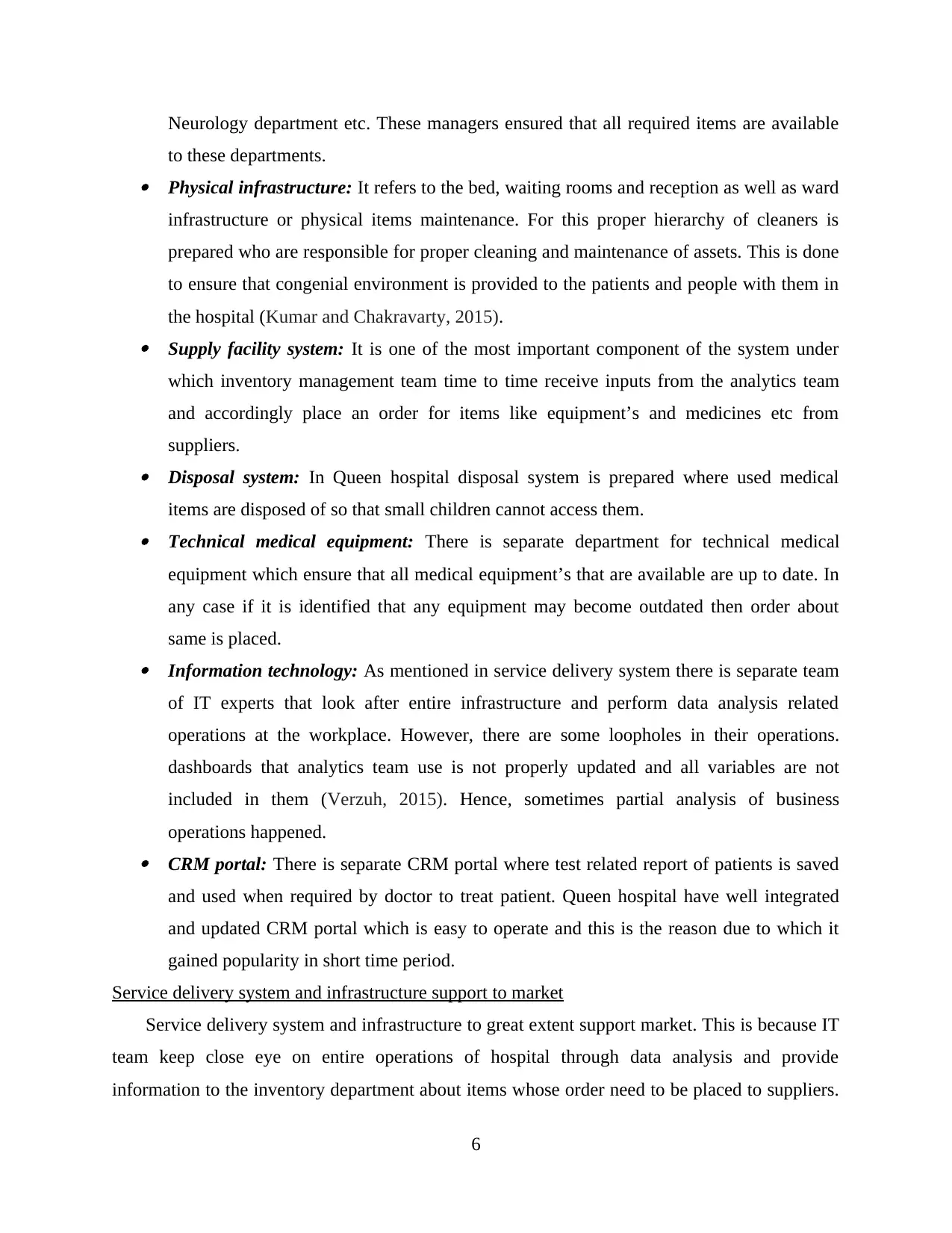
Neurology department etc. These managers ensured that all required items are available
to these departments. Physical infrastructure: It refers to the bed, waiting rooms and reception as well as ward
infrastructure or physical items maintenance. For this proper hierarchy of cleaners is
prepared who are responsible for proper cleaning and maintenance of assets. This is done
to ensure that congenial environment is provided to the patients and people with them in
the hospital (Kumar and Chakravarty, 2015). Supply facility system: It is one of the most important component of the system under
which inventory management team time to time receive inputs from the analytics team
and accordingly place an order for items like equipment’s and medicines etc from
suppliers. Disposal system: In Queen hospital disposal system is prepared where used medical
items are disposed of so that small children cannot access them. Technical medical equipment: There is separate department for technical medical
equipment which ensure that all medical equipment’s that are available are up to date. In
any case if it is identified that any equipment may become outdated then order about
same is placed. Information technology: As mentioned in service delivery system there is separate team
of IT experts that look after entire infrastructure and perform data analysis related
operations at the workplace. However, there are some loopholes in their operations.
dashboards that analytics team use is not properly updated and all variables are not
included in them (Verzuh, 2015). Hence, sometimes partial analysis of business
operations happened. CRM portal: There is separate CRM portal where test related report of patients is saved
and used when required by doctor to treat patient. Queen hospital have well integrated
and updated CRM portal which is easy to operate and this is the reason due to which it
gained popularity in short time period.
Service delivery system and infrastructure support to market
Service delivery system and infrastructure to great extent support market. This is because IT
team keep close eye on entire operations of hospital through data analysis and provide
information to the inventory department about items whose order need to be placed to suppliers.
6
to these departments. Physical infrastructure: It refers to the bed, waiting rooms and reception as well as ward
infrastructure or physical items maintenance. For this proper hierarchy of cleaners is
prepared who are responsible for proper cleaning and maintenance of assets. This is done
to ensure that congenial environment is provided to the patients and people with them in
the hospital (Kumar and Chakravarty, 2015). Supply facility system: It is one of the most important component of the system under
which inventory management team time to time receive inputs from the analytics team
and accordingly place an order for items like equipment’s and medicines etc from
suppliers. Disposal system: In Queen hospital disposal system is prepared where used medical
items are disposed of so that small children cannot access them. Technical medical equipment: There is separate department for technical medical
equipment which ensure that all medical equipment’s that are available are up to date. In
any case if it is identified that any equipment may become outdated then order about
same is placed. Information technology: As mentioned in service delivery system there is separate team
of IT experts that look after entire infrastructure and perform data analysis related
operations at the workplace. However, there are some loopholes in their operations.
dashboards that analytics team use is not properly updated and all variables are not
included in them (Verzuh, 2015). Hence, sometimes partial analysis of business
operations happened. CRM portal: There is separate CRM portal where test related report of patients is saved
and used when required by doctor to treat patient. Queen hospital have well integrated
and updated CRM portal which is easy to operate and this is the reason due to which it
gained popularity in short time period.
Service delivery system and infrastructure support to market
Service delivery system and infrastructure to great extent support market. This is because IT
team keep close eye on entire operations of hospital through data analysis and provide
information to the inventory department about items whose order need to be placed to suppliers.
6
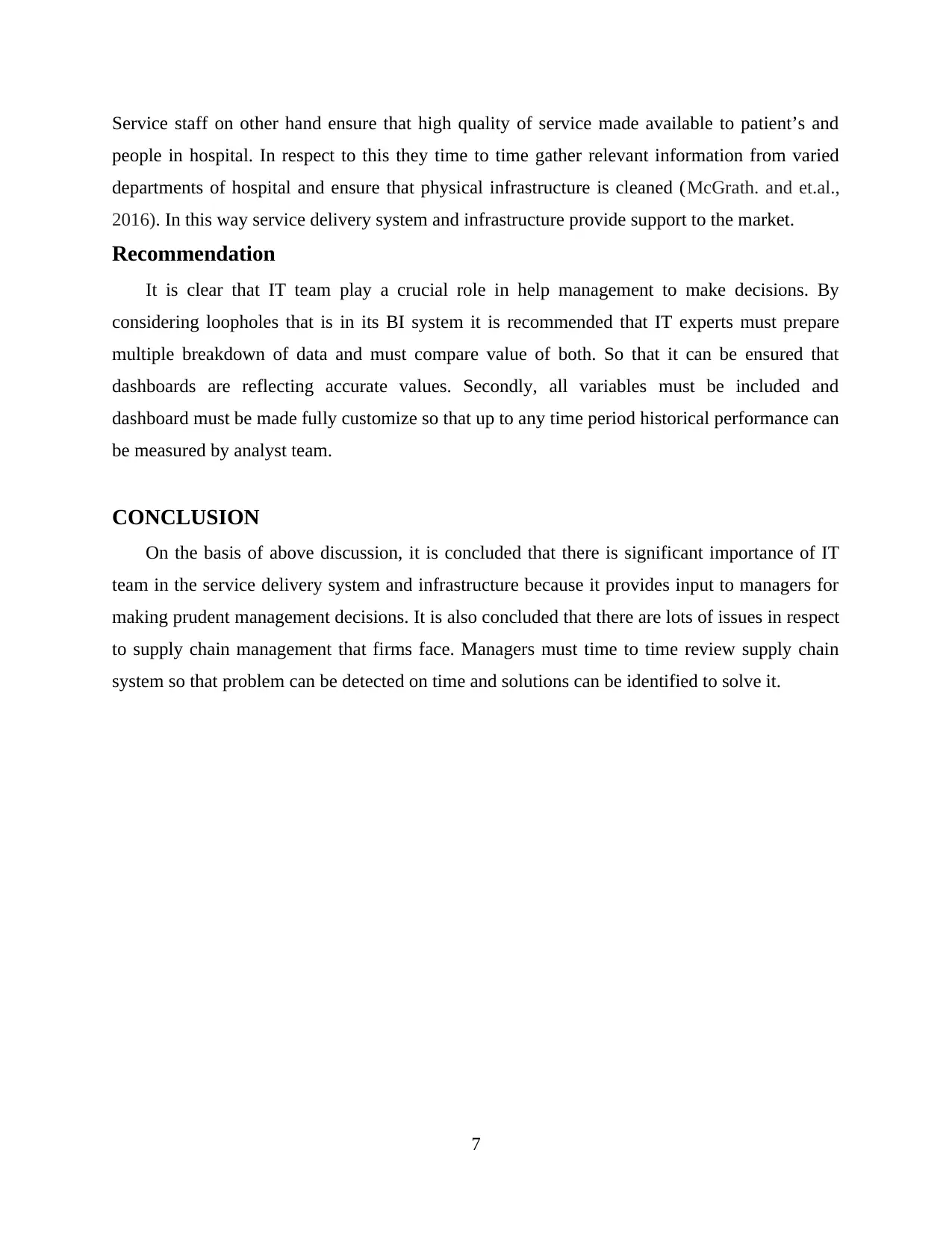
Service staff on other hand ensure that high quality of service made available to patient’s and
people in hospital. In respect to this they time to time gather relevant information from varied
departments of hospital and ensure that physical infrastructure is cleaned (McGrath. and et.al.,
2016). In this way service delivery system and infrastructure provide support to the market.
Recommendation
It is clear that IT team play a crucial role in help management to make decisions. By
considering loopholes that is in its BI system it is recommended that IT experts must prepare
multiple breakdown of data and must compare value of both. So that it can be ensured that
dashboards are reflecting accurate values. Secondly, all variables must be included and
dashboard must be made fully customize so that up to any time period historical performance can
be measured by analyst team.
CONCLUSION
On the basis of above discussion, it is concluded that there is significant importance of IT
team in the service delivery system and infrastructure because it provides input to managers for
making prudent management decisions. It is also concluded that there are lots of issues in respect
to supply chain management that firms face. Managers must time to time review supply chain
system so that problem can be detected on time and solutions can be identified to solve it.
7
people in hospital. In respect to this they time to time gather relevant information from varied
departments of hospital and ensure that physical infrastructure is cleaned (McGrath. and et.al.,
2016). In this way service delivery system and infrastructure provide support to the market.
Recommendation
It is clear that IT team play a crucial role in help management to make decisions. By
considering loopholes that is in its BI system it is recommended that IT experts must prepare
multiple breakdown of data and must compare value of both. So that it can be ensured that
dashboards are reflecting accurate values. Secondly, all variables must be included and
dashboard must be made fully customize so that up to any time period historical performance can
be measured by analyst team.
CONCLUSION
On the basis of above discussion, it is concluded that there is significant importance of IT
team in the service delivery system and infrastructure because it provides input to managers for
making prudent management decisions. It is also concluded that there are lots of issues in respect
to supply chain management that firms face. Managers must time to time review supply chain
system so that problem can be detected on time and solutions can be identified to solve it.
7
⊘ This is a preview!⊘
Do you want full access?
Subscribe today to unlock all pages.

Trusted by 1+ million students worldwide
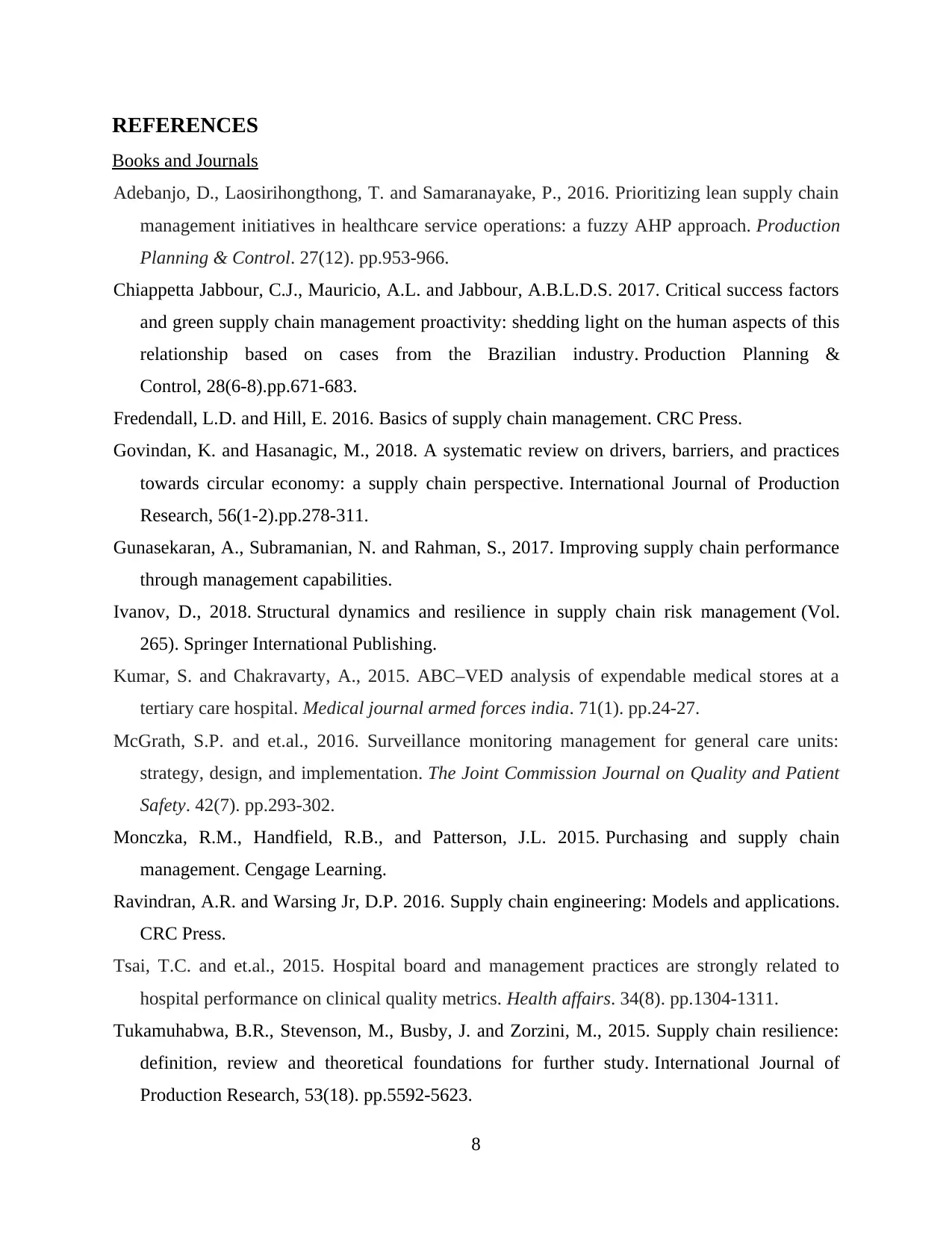
REFERENCES
Books and Journals
Adebanjo, D., Laosirihongthong, T. and Samaranayake, P., 2016. Prioritizing lean supply chain
management initiatives in healthcare service operations: a fuzzy AHP approach. Production
Planning & Control. 27(12). pp.953-966.
Chiappetta Jabbour, C.J., Mauricio, A.L. and Jabbour, A.B.L.D.S. 2017. Critical success factors
and green supply chain management proactivity: shedding light on the human aspects of this
relationship based on cases from the Brazilian industry. Production Planning &
Control, 28(6-8).pp.671-683.
Fredendall, L.D. and Hill, E. 2016. Basics of supply chain management. CRC Press.
Govindan, K. and Hasanagic, M., 2018. A systematic review on drivers, barriers, and practices
towards circular economy: a supply chain perspective. International Journal of Production
Research, 56(1-2).pp.278-311.
Gunasekaran, A., Subramanian, N. and Rahman, S., 2017. Improving supply chain performance
through management capabilities.
Ivanov, D., 2018. Structural dynamics and resilience in supply chain risk management (Vol.
265). Springer International Publishing.
Kumar, S. and Chakravarty, A., 2015. ABC–VED analysis of expendable medical stores at a
tertiary care hospital. Medical journal armed forces india. 71(1). pp.24-27.
McGrath, S.P. and et.al., 2016. Surveillance monitoring management for general care units:
strategy, design, and implementation. The Joint Commission Journal on Quality and Patient
Safety. 42(7). pp.293-302.
Monczka, R.M., Handfield, R.B., and Patterson, J.L. 2015. Purchasing and supply chain
management. Cengage Learning.
Ravindran, A.R. and Warsing Jr, D.P. 2016. Supply chain engineering: Models and applications.
CRC Press.
Tsai, T.C. and et.al., 2015. Hospital board and management practices are strongly related to
hospital performance on clinical quality metrics. Health affairs. 34(8). pp.1304-1311.
Tukamuhabwa, B.R., Stevenson, M., Busby, J. and Zorzini, M., 2015. Supply chain resilience:
definition, review and theoretical foundations for further study. International Journal of
Production Research, 53(18). pp.5592-5623.
8
Books and Journals
Adebanjo, D., Laosirihongthong, T. and Samaranayake, P., 2016. Prioritizing lean supply chain
management initiatives in healthcare service operations: a fuzzy AHP approach. Production
Planning & Control. 27(12). pp.953-966.
Chiappetta Jabbour, C.J., Mauricio, A.L. and Jabbour, A.B.L.D.S. 2017. Critical success factors
and green supply chain management proactivity: shedding light on the human aspects of this
relationship based on cases from the Brazilian industry. Production Planning &
Control, 28(6-8).pp.671-683.
Fredendall, L.D. and Hill, E. 2016. Basics of supply chain management. CRC Press.
Govindan, K. and Hasanagic, M., 2018. A systematic review on drivers, barriers, and practices
towards circular economy: a supply chain perspective. International Journal of Production
Research, 56(1-2).pp.278-311.
Gunasekaran, A., Subramanian, N. and Rahman, S., 2017. Improving supply chain performance
through management capabilities.
Ivanov, D., 2018. Structural dynamics and resilience in supply chain risk management (Vol.
265). Springer International Publishing.
Kumar, S. and Chakravarty, A., 2015. ABC–VED analysis of expendable medical stores at a
tertiary care hospital. Medical journal armed forces india. 71(1). pp.24-27.
McGrath, S.P. and et.al., 2016. Surveillance monitoring management for general care units:
strategy, design, and implementation. The Joint Commission Journal on Quality and Patient
Safety. 42(7). pp.293-302.
Monczka, R.M., Handfield, R.B., and Patterson, J.L. 2015. Purchasing and supply chain
management. Cengage Learning.
Ravindran, A.R. and Warsing Jr, D.P. 2016. Supply chain engineering: Models and applications.
CRC Press.
Tsai, T.C. and et.al., 2015. Hospital board and management practices are strongly related to
hospital performance on clinical quality metrics. Health affairs. 34(8). pp.1304-1311.
Tukamuhabwa, B.R., Stevenson, M., Busby, J. and Zorzini, M., 2015. Supply chain resilience:
definition, review and theoretical foundations for further study. International Journal of
Production Research, 53(18). pp.5592-5623.
8
Paraphrase This Document
Need a fresh take? Get an instant paraphrase of this document with our AI Paraphraser
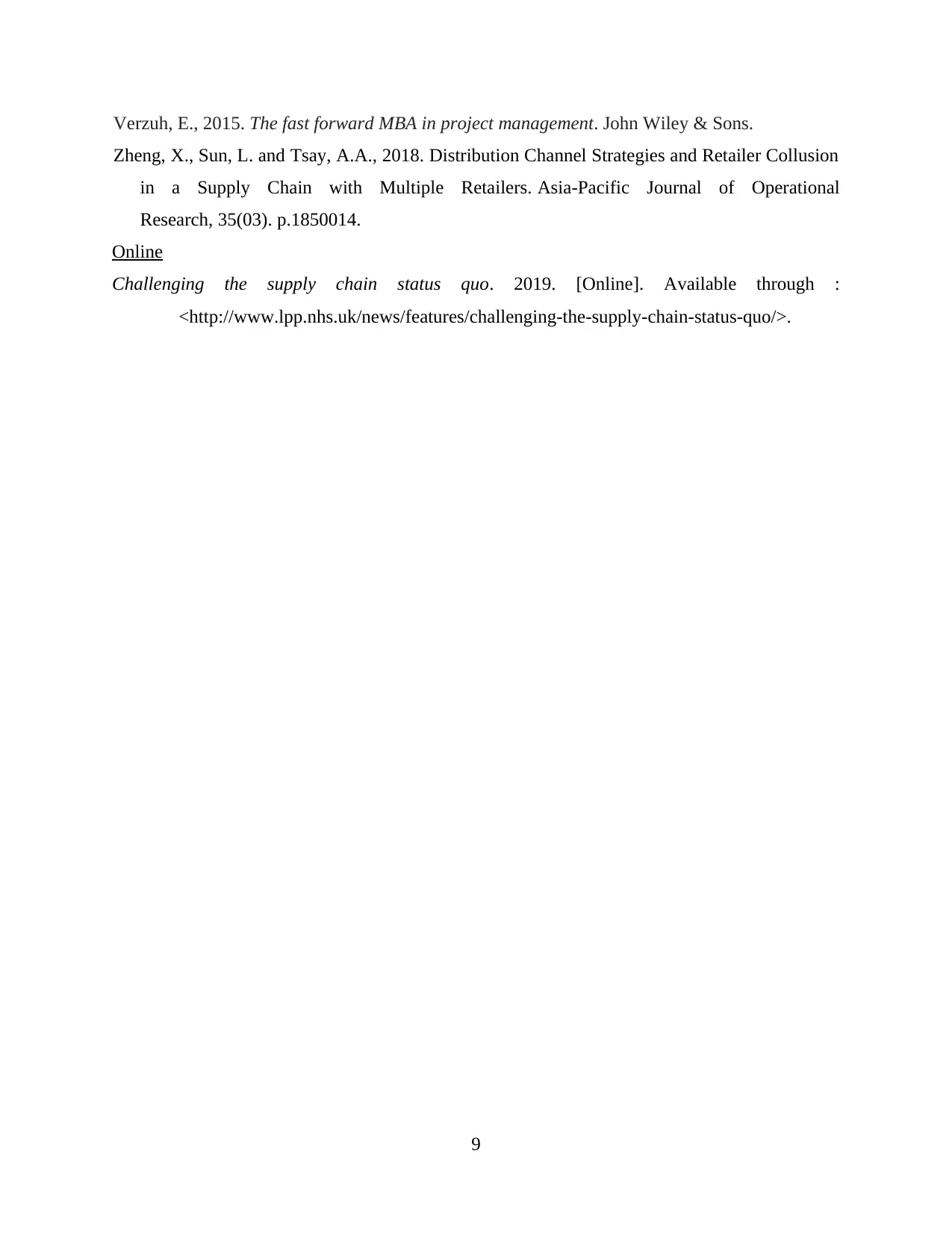
Verzuh, E., 2015. The fast forward MBA in project management. John Wiley & Sons.
Zheng, X., Sun, L. and Tsay, A.A., 2018. Distribution Channel Strategies and Retailer Collusion
in a Supply Chain with Multiple Retailers. Asia-Pacific Journal of Operational
Research, 35(03). p.1850014.
Online
Challenging the supply chain status quo. 2019. [Online]. Available through :
<http://www.lpp.nhs.uk/news/features/challenging-the-supply-chain-status-quo/>.
9
Zheng, X., Sun, L. and Tsay, A.A., 2018. Distribution Channel Strategies and Retailer Collusion
in a Supply Chain with Multiple Retailers. Asia-Pacific Journal of Operational
Research, 35(03). p.1850014.
Online
Challenging the supply chain status quo. 2019. [Online]. Available through :
<http://www.lpp.nhs.uk/news/features/challenging-the-supply-chain-status-quo/>.
9
1 out of 11
Related Documents
Your All-in-One AI-Powered Toolkit for Academic Success.
+13062052269
info@desklib.com
Available 24*7 on WhatsApp / Email
![[object Object]](/_next/static/media/star-bottom.7253800d.svg)
Unlock your academic potential
Copyright © 2020–2025 A2Z Services. All Rights Reserved. Developed and managed by ZUCOL.





